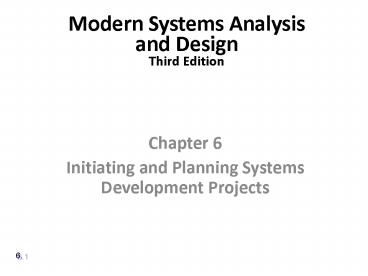Modern Systems Analysis and Design Third Edition - PowerPoint PPT Presentation
Title:
Modern Systems Analysis and Design Third Edition
Description:
Modern Systems Analysis and Design Third Edition Chapter 6 Initiating and Planning Systems Development Projects 6.* Initiating and Planning System Development ... – PowerPoint PPT presentation
Number of Views:268
Avg rating:3.0/5.0
Title: Modern Systems Analysis and Design Third Edition
1
Modern Systems Analysisand DesignThird Edition
- Chapter 6
- Initiating and Planning Systems Development
Projects
6.1
2
Initiating and Planning System Development
Projects
- Project Initiation
- Establishment of project team
- Development of relationship with customer
- Project Initiation Plan
- Establishment of Management Procedures
- Establishment of Project Workbook and Project
Management Environment - Project Planning
- Defining clear, discrete activities and the work
needed to complete each activity
6.2
3
Initiating and Planning System Development
Projects
- Deliverables and Outcomes
- Baseline Project Plan (BPP)
- Scope
- Benefits
- Costs
- Risks
- Resources
- Statement of Work (SOW)
- Describes deliverables
- Outlines work needed to be performed
6.3
4
Assessing Project Feasibility
- Six Categories
- Economic
- Technical
- Operational
- Schedule
- Legal and contractual
- Political
6.4
5
Assessing Economic Feasibility
- Cost Benefit Analysis
- Determine Benefits
- Tangible Benefits
- Can be measured easily
- Examples
- Cost reduction and avoidance
- Error reduction
- Increased flexibility
- Increased speed of activity
- Improved management planning and control
- Opening new markets and increasing sales
opportunities
6.5
6
Assessing Economic Feasibility
- Intangible Benefits
- Cannot be measured easily
- Examples
- Increased employee morale
- Competitive necessity
- More timely information
- Promotion of organizational learning and
understanding - Determine Costs
- Tangible Costs
- Can easily be measured in dollars
- Example Hardware
- Intangible Costs
- Cannot be easily measured in dollars
- Examples
- Loss of customer goodwill
- Loss of employee morale
6.6
7
Assessing Economic Feasibility
- One-Time Costs
- Associated with project startup, initiation and
development - Includes
- System Development
- New hardware and software purchases
- User training
- Site preparation
- Data or system conversion
6.7
8
Assessing Economic Feasibility
- Recurring Costs
- Associated with ongoing use of the system
- Includes
- Application software maintenance
- Incremental data storage expense
- New software and hardware releases
- Consumable supplies
- Incremental communications
- Time value of money (TVM)
- The process of comparing present cash outlays to
future expected returns
6.8
9
Assessing Technical Feasibility
- Technical Feasibility
- Assessment of the development organizations
ability to construct a proposed system - Project risk can be assessed based upon
- Project size
- Project structure
- Development groups experience with the
application - User groups experience with development projects
and the application area
6.9
10
Assessing Other Project Feasibility Concerns
- Operational Feasibility
- Assessment of how a proposed system solves
business problems or takes advantage of
opportunities - Schedule Feasibility
- Assessment of time frame and project completion
dates with respect to organization constraints
for affecting change - Legal and Contractual Feasibility
- Assessment of legal and contractual ramifications
of new system - Political Feasibility
- Assessment of key stakeholders in organizations
view toward proposed system
6.10
11
Building the Baseline Project Plan
- Objectives
- Assures that customer and development group have
a complete understanding of the proposed system
and requirements - Provides sponsoring organization with a clear
idea of scope, benefits and duration of project - Four Sections
- Introduction
- System Description
- Feasibility Assessment
- Management Issues
6.11
12
Building the Baseline Project Plan
- Introduction
- Brief overview
- Recommended course of action
- Project scope defined
- Units affected
- Who inside and outside the organization would be
involved - Interaction with other systems
- Range of system capabilities
- System Description
- Outline of possible alternative solutions
- Narrative format
6.12
13
Building the Baseline Project Plan
- Feasibility Assessment
- Project costs and benefits
- Technical difficulties
- High-level project schedules
- Management Issues
- Outlines concerns that management may have about
the project - Team composition
- Communication plan
- Objectives
- Assure conformity to organizational standards
- All parties agree to continue with project
6.13
14
Reviewing the Baseline Project Plan
- Walkthrough
- Peer group review
- Participants
- Coordinator
- Presenter
- User
- Secretary
- Standards Bearer
- Maintenance Oracle
- Activities
- Walkthrough Review Form
- Individuals polled
- Walkthrough Action List
- Advantages
- Assures that review occurs during project
6.14






























